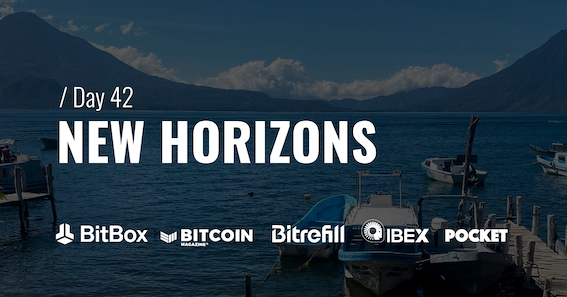- Podcast
- Supportaci
- Blog
- Shopping
- Bitcoin
- Contattaci

For the past few days we have been totally off grid. By totally I mean that we have electricity only a couple of hours a day and satellite internet that barely allows us to upload a few photos. Quite a challenge for Bitcoin. Yet we must realize that there are such places in the world. More than we can imagine. We need to take that into account and refine the technology with answers that can adapt even to extreme conditions like this.
We have therefore left Lake Atitlan, Bitcoin Lake. And so it is time to draw some conclusions.
We are thrilled. It surprised us positively beyond our wildest expectations.
The lake is a well-known tourist spot, very popular among the people of Guatemala. But we also crossed paths with many foreign tourists. On its shores rise several towns, some larger ones, such as Panajachel, where there really is everything one could want to spend a few weeks of leisure and rest, and other smaller towns, for example San Marcos, totally immersed in nature and definitely more suitable for those who want to relax, meditate or hike.
There is one thing, however, that unites the entire lake, with no exclusion of locations: cash. Even in Guatemala, a large segment of the population does not have access to a bank account, and even if they do, the costs of managing it, or those of electronic payment instruments, are exorbitant. You will soon realize this, because as you travel here you will realize that the few businesses that accept credit cards charge 5 or 10 percent more on your account if you want to pay with Visa or Mastercard. Ideal conditions for building an alternative economy in Bitcoin. And in fact, Lake Atitlan is taking notice. In Guatemala there are bitcoin wallets, such as Osmo, that allow you to receive quetzales or even U.S. dollars, if the user does not want (for the moment) to keep the sats they receive. Applications like these, thanks to the bitcoin protocol, really replace a bank account or POS totally free of charge. That’s why there is so much enthusiasm on the lake for this technological innovation, and that’s why adoption is growing so strongly. When you consider that the Bitcoin Lake experiment started not even a year ago, it is impressive how many businesses and merchants are already accepting them. There is a really dragging, addictive enthusiasm. And we have no doubt that this will be a popular destination for bitcoiners in the coming years. After all, for what reason should anyone visiting Bitcoin Beach in El Salvador not spend a few days here as well? There are private buses that directly connect El Tunco, the town immediately adjacent to El Zonte, far more touristy and well-equipped, with Lake Atitlan. It only takes a few hours of travel, is an extremely inexpensive transportation option, and you will pass through majestic landscapes, traveling along safe roads.
Central America is waking up. It is a region with tremendous economic and tourism potential, and bitcoin here meets real needs. The bitcoin traveler’s horizons, in short, are expanding rapidly and, we have shown, the carnet of his options already is not limited only to El Salvador.